The Malletsheugh Inn.
Newton Mearns, Glasgow.
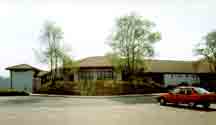
The Malletsheugh Inn. 1991.
The Malletsheugh Inn is the most conspicuous house on the road to Kilmarnock, via Newton Mearns. This wayside inn was as popular in the 1890s as it is today, and is associated with old stage coaching days.
The Malletsheugh Inn was a plain substantial building of two storey with an attic. It was just a trifle more than eight miles from Glasgow, measuring from the Exchange, and more than five hundred feet above the level of the sea. From the attic windows the view is almost panoramic. The broad valley of the Clyde, with the city lying in its lap, spreads out before the spectator in all its fertile fairness.
On a clear day, the masts on the ships proceeding up and down the river are easily discerned, while from a hillock within a few yards of the house the great clock of Kilbowie, on the road to Dumbarton, may be seen with such distinctness that so some it tells the time.
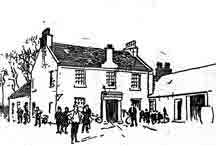
The Old Malletsheugh Inn. 1893.
The Malletsheugh was built in the 1830s by Mr James Allison, his son inherited the property and carried out several important improvements in the parish. James died at Malletsheugh Farm, which belonged to him and was in the possession of his descendants for years. He died at the ripe old age of eighty four. For many years the inn was the scene of the first change of horses in the coach that ran from Glasgow to Kilmarnock. In structure it has been slightly altered since the trade went off the road, to employ the words of young Mr King, who assisted his mother in the management of the inn, and by which is meant, since the stage coach and the carriers carts were superseded by the railway, but substantially the building is the same.
The doorway in the gable end touching on the road, by which passengers entered or left the inn, may still be traced; the brackets of the lamp which, when the night was dark, throughout a cherry light to the weary wayfarer, or filled the mind of the more fortunate occupant of the coach, while yet a long way off, with thoughts of the welcome awaiting him at the inn, projects to this day from the corner of the inn; while the old-fashioned pump with its huge stone trough, at which the horses were wont to water, stands near the house, to all but those who know its value as an instrument of domestic utility, the scarecrow of its former glory.
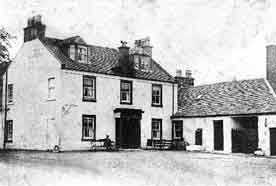
The Malletsheugh Inn. circa 1910.
Mrs. King occupied the inn in 1873 and looked after the customers for well over twenty years. The companionship of her son and daughter helped her through the years in the running of the inn, she spent most of her life at the inn, and the fact that she was living almost on the very spot upon which she was born, amid the scenes of her childhood and conclude with the recollection that the situation of her house is agreeable in every respect and then say how many there are who would not change their lot with her.
The Malletsheugh Inn was renowned for the cyclists of the day, especially on a Saturday morning, when riders would gather on their way to cycling in the country. There are two things in particular that account for the growing repute of the inn as a cycling resort, namely, the fact that cycles may be left anywhere about the place without a fear as to their safety, there being nobody about to meddle with them; and secondly, a little lavatory, erected recently in one of the out-houses, wherein the soiled cyclist- be it mud, dust or oil that he wishes to remove, finds all the requisites necessary for his external refreshment, and that without having to enter the inn.
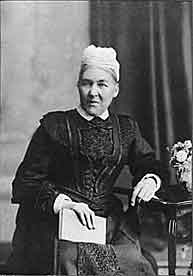
Mrs. King, landlady of the Inn.
Mrs. King found the cyclists who visited the inn to be very pleasant fellows to deal with. They are all temperate; in many cases teetotal. One or other of the none-intoxicating drinks from, as a rule, their refreshment, supplemented not infrequently, by those who make the Malletsheugh the limit of their ride, by a hearty tea. Mrs. King was a favourite amongst cyclists is also evident from a stray remark in "The Wanderer's" notes. A few weeks age in 1893, three or four of the more prominent members of a Glasgow Club presented her with a handsome case of cutlery in testimony of their and their fellow-cyclists appreciation for her merits as hostess of the Malletsheugh Inn.
The following information came from a very well documented family history courtesy of John Hendry, his website on the Malletsheugh Inn can be read at http://www.genealogy.jejik.co.uk/allison/appendixf.htm
These snippets are from Mr Hendry's website....
The first traceable members of the Allison family was Robert Allison a farmer at the Malletsheugh, Mearns. The first actual record was a Baptism record of their son James, the next generation in the family was on 9th June 1782.
In 1851 35 year old Allan Pollok was living with his wife Mary and son Allan and running the Malletsheugh Inn. It would seem likely that Allan Pollok was related to the Allison family through James Allison's wife Margaret Ritchie, whose mother was Jean Pollok.
On the 8th June 1860, William Allison, James and Margaret's youngest son was running the Inn. Many members of the family were born and died in the Malletsheugh Inn. In 1861 William Allison was 35 years of age, his wife Christina was 26, they had a son Andrew, daughter Margaret.
When William Allison took over the Inn is not known, other than he was in residence at the time of the census returns on the 8th April 1861, he gave up the Inn before May 1865. In 1871 the Inn was being run by William Allison's nephew, William Andrew. In the same year Janet and her husband Alexander King were living at 32 Stockwell Street running a wine & spirit business. Twenty years later Janet and her daughter Annie, son William were living at the Malletsheugh Inn, there was also a grand daughter Bessie Innes staying with then. Bessie was the daughter of Agnes Wilson, Janet's youngest daughter from her previous marriage to John Wilson. Agnes had married a Joseph A Innes another spirit merchant.
In 1881 the Malletsheugh Inn had changed hands. The head of the household was Alexander King his wife Janet had the link to the Inn, Alexander King was only 36 years of age, his wife was 50. Alexander died 9th February 1891, the Inn was then run by his widow Janet. There were farm cottages near the Inn where members of the Allison family were living.
In 1891 Janet King was a spirit merchant and landlady of the Malletsheugh Inn, her young family were also working in the Inn as bar salesmen. Janet died 31st Aug. 1913 at the Inn. She was 85 years of age.
Main roads such as the Mearns _ Kilmarnock road were built by private companies, who would charge a Toll on the road to pay for the upkeep of the road and presumably generated a profit for the company. Many family members worked as turnpikes in there day. This Toll seems to have been franchised out as illustrated by the following, advert from the back page of the Glasgow Chronicle, 24th March 1835 of the sale by public roup of the franchises on various tolls...
Longswell this year £810, last year £75.
Dodside this year £55, last year £40.
Ouply-Shilford this year £385, last year £315.
Neilson this year £100, last year £35.
Pollokshaws this year £3290, last year £3200.
Ouply is now known as Uplawmoor.
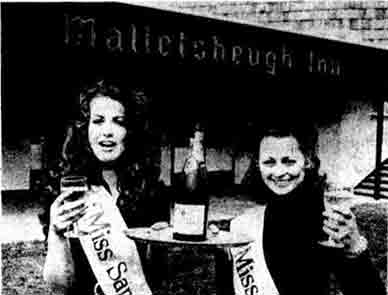
Former Miss United Kingdom Sheena Drummond and Una Watt enjoying the celebrations at the opening this week of the Malletsheugh Inn. 1971.
In the News 1971...
The Old Dutch Inn takes on a new look.
For 300 years or more an old inn of Dutch design has stood proudly on a busy crossroads, a short distance from Newton Mearns Cross.
The Malletsheugh Inn was its name and it was a favourite stopping off spot for motorists travelling in and out of Glasgow along the road to the coast. Eleven years ago Tennent Caledonian took over the old place and a few months ago it was decided to update the old rendezvous.
It's still called the Malletsheugh, but it is drastically different from the old place. It is large, impressive, and very different from anything else I have seen. The name of the different sections give a clue to the decor, there's the Baron's Bar, the Baronial Restaurant, Grill and the Stag Bar. Decor alone rarely gives the whole atmosphere yet here it contributes greatly. Timber has been used to considerable extent, chiefly in long struts to give a lowering effect to the high roof. This, cleverly, used as it is, gives a "barn" look to the place.
Luxurious
But don't get the impression that visitors will have to put up with barn-like standards of comfort. Far from it. Luxurious furnishings have been combined with unusual and attractive colour schemes and the finished product in one of elegance.
Take the Baron's Bar for example. that is the lounge bar. You enter it by climbing three or four stairs until you think your head will touch the low rafters, but of course, there's really plenty of head-room for the lofties customer. The same carpet runs throughout the Malletsheugh, it is in shades of blue and purple and red, and the seating in the lounge bar tones nicely, with its mustard coloured covering. The entire building is erected on a semi-circular basis, giving added interest both from outside and in.
At the opposite end of the foyer the soft lights and sweet music of the Baronial Restaurant-Grill beckon you to sample the talents of Chef Fred Robins. Here the design is on two levels, the centre semi-circle offering seating for those pre-meal cocktails, and the lower and outer semi-circle seating up to 70 visitors who are dining as well as wining.
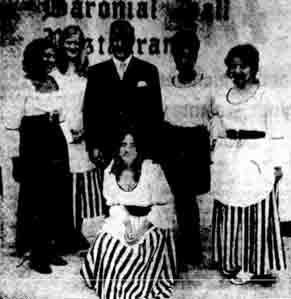
At your service. Manager Mr Archie McKelvie with his staff. 1971.
The bright kitchen, where a staff of seven make easy work of a demanding menu is a haven of spotless stainless steel and all the latest kitchen gadgetry.
Solid Oak
No eating and drinking house would be complete without a retreat for the man of the house. The Stag Bar is just that, even presenting a masculine look in the decor. Solid oak pillars combine with plenty of brass-work and cheerfully painted wooden tables and chairs.
There is also an off-sales shop at the Malletsheugh, and there customers can also buy food from the delicatessen so that they can under the one roof, buy all they need for a home cocktail party. More than that, manager Archie McKelvie tells me, full scale meals can be ordered in advance and prepared in the inn's kitchen ready to be taken away for that extra special home party.
Central Store
The design of the Malletsheugh has cleverly been worked around a central store. The kitchen, restaurant, and the two bars all lead off at the back to the store.
The new look Malletsheugh is a showpiece of ingenious design. I asked Mr McKelvie what the name meant, "We don't really know," he said. "Sheugh means ditch, and we presume the Mallet part was some one's name, maybe a farmer who had land here; it would be interesting to find out just what it does mean"
Englishman with a taste for Scotland...
After 30 years north of the border Fred Robins still sounds like a Londoner, and London's loss has been Glasgow's gain, for Fred, now head chef at the Malletsheugh Inn has been catering for Glasgow diners ever since he set foot on Scottish soil. "I might still sound English but my heart is in Scotland, I have Scottish children." he laughed. "These days a head chef has to be a working chef. There's none of this sitting in an office all day writing menus. It's so difficult to get kitchen staff that a head chef has to work along with them. It's a demanding job, 10a.m. to 10 p.m. tends to put the youngsters off a bit these days."
Good broth
Chef Robins might be excused for taking the easy way out and falling back on the numerous ready-prepared foods available now. "I don't criticise these frozen and powered foods. they are very handy when you are busy, but I don't like to use them all the time and I always make my own soups, I believe in a good broth," he said.
The Malletsheugh menu is in English and slanted towards good Scots fare. "But," says Fred, "providing we are given adequate warning we will prepare anything anyone wants."
How New Inn Took Shape...
Designed by Glasgow architect A. McInnes, Gardner & Partners, the responsibility for the success of the new Malletsheugh Inn lay with Lawrence Construction Company Limited, also of Glasgow, who as main contractor coordinated the various trades involved, including the labour force of Tennent Caledonian Breweries Ltd., who carried out much of the work.
The quick switch over from old to new, taking only four weeks, was achieved with the minimum interruption to business by building the new inn immediately behind the existing premises, then, when it was almost complete, the old building was demolished to provide parking for some 80 cars.
Site advantage
In planning the new inn, care was taken to exploit the full natural advantages of the site and the new building enjoys commanding views to the north. Interesting features of the internal treatment of the inn are the variation in floor levels, the extensive use in the three public rooms and the unusual treatment of plastered wall surfaces.
Externally, an original effect has been obtained by the use of Canadian cedar tiles. An additional feature, which contributes to the general appearance of the inn is the preservation of existing mature trees.
-----------------------------------------------
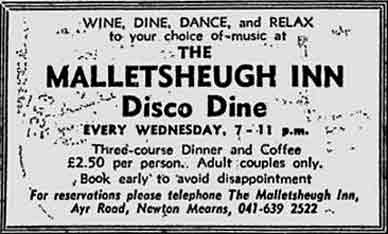
Malletsheugh Inn advert 1978.
End.
